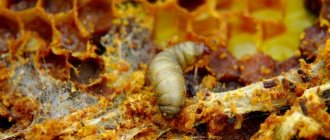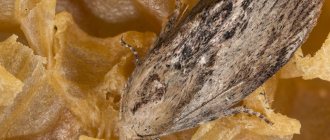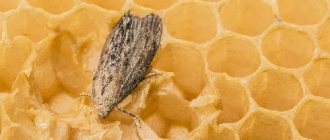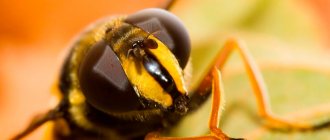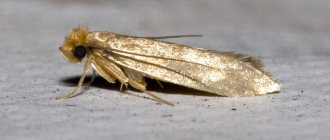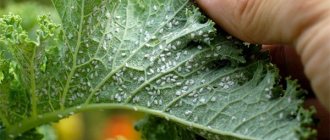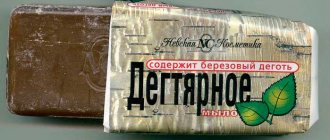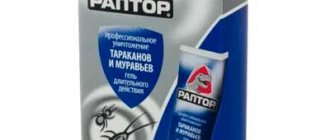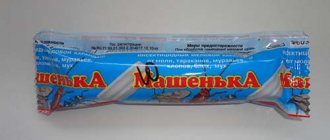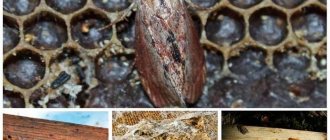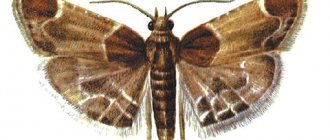Science is rapidly moving along the path of development, which makes it possible to create more and more new therapeutic drugs to combat various diseases. However, microorganisms harmful to humans quickly adapt to new drugs. Numerous laboratories around the world have to again look for ways to treat seemingly already defeated diseases.
Things are a little different when treating with folk remedies. Here the pathogens cannot yet decide to adapt and solve the problem of their survival. Why is this happening? No answer yet. Perhaps the rare use of such drugs does not allow pathogens to accumulate information and mutate. Perhaps nature itself has provided for everything so cleverly that, having placed natural remedies against bacteria and viruses in the hands of humans, it has blocked their ability to resist.
One of the most powerful folk remedies for the treatment of various diseases is bee moth tincture.
Who is the bee moth?
Beekeepers have one misfortune with which they constantly struggle. This is a wax moth. The name is collective for two species of these winged pests. Includes large (lat. Galleria mellonella) and small (Achroia grisella) wax moth. Both species are from the moth family (Pyralidae). That's why they are also called bee moths. There is also a poetic name - golden butterfly. That's what it was called in Ancient Greece.
It is not the butterfly itself that is harmful in the hive - it does not feed in this phase of development and lives off the nutrients accumulated by the larvae, but the worms that emerge from the eggs are a real scourge. Eggs are laid in the hive at night for several days in a row, after which the adult insect dies. After 5 days, larvae begin to emerge from the eggs. They are pale gray in color, about 1 mm long. In the first days of their existence, they eat honey and bee bread.
Important. If wax moth larvae are not dealt with, bee colonies weaken and die, or simply leave the hive.
As the caterpillars grow older, their diet expands - royal jelly, honeycomb and propolis are used. A few days before the transformation, moth caterpillars devour frames, insulating material, and even each other. Experiments have shown that these are the only representatives of the flora capable of eating and digesting polyethylene. During the experiments, holes appeared on the polyethylene film after just 20 minutes, and after 40 minutes the film almost completely disappeared. Caterpillars can digest chemically complex products such as wax and polyethylene with the help of special enzymes.
Interesting. The composition of the digestive enzymes of bee moths has not been fully studied. Various publications refer to the enzyme cerase. However, this enzyme is not mentioned in any scientific work. There is no chemical formula either.
After a month, having reached 2 cm in length, the caterpillar transforms into a cocoon. It is during this period, a few days before its transformation, that light yellow, sedentary and very voracious worms are collected, necessary for preparing ointments and tinctures at home.
How is moth tincture useful?
If we look at statistics, in the 19th century every 7 inhabitants died from transient consumption in Europe. And in the 20th century, the disease continued to remain the most common in the world. The disease is caused by tuberculous microbacteria, which most often affect the respiratory organs, although in practice tuberculosis of the joints, bones, eyes, genitourinary organs, and peripheral lymph nodes occurs.
Since the bacteria that cause tuberculosis are covered on top with a shell similar in chemical composition to wax, it has been suggested that an enzyme called cerrase, contained in the digestive tract of wax moth larvae, which helps them absorb wax as food, can also successfully affect the outer shell of the tuberculosis moth. sticks, split it and destroy it.
The belief about the unconditional usefulness of this drug for the treatment of tuberculosis is based on this assumption. The use of a tincture containing special enzymes of bee moth larvae helps in the resorption of focal changes. And numerous reviews from patients who have used the healing drug confirm the fact of its positive effect on the treatment of this serious disease.
However, scientists do not confirm the existence in biochemistry of such a substance as cerrase. And the fact of death of the tuberculosis pathogen in the human body under the influence of this enzyme is also not confirmed by reliable data. Nevertheless, the popularity of bee moth tincture in alternative medicine is constantly growing; its new healing properties are being experimentally discovered, thanks to the extraordinary biomaterial from which it was prepared.
Chemical analysis of the raw materials confirmed that moth larvae contain a lot of useful substances with excellent antioxidant and stimulating properties, which make it possible to use medicinal products prepared on their basis in the treatment of various diseases.
The main part of bee moth extract consists of amino acids:
- Alanine – good for the brain;
- serine is an essential component in the synthesis of many natural proteins;
- valine – affects the immune system;
- a group of amino acids that inhibit the aging process and promote rejuvenation of the body.
In addition to amino acids, the tincture contains trace elements, fatty acids, monosaccharides, and unique enzymes that can digest wax and destroy the protective coating of bacteria.
According to patient reviews, regular use of this product:
- improves the functioning of internal organs, the immune system, blood circulation, metabolism;
- promotes the healing of scars, cicatrices, abrasions;
- recovery processes occur faster in the body, hemoglobin and red blood cells return to normal;
- muscle work is stimulated, wrinkles are smoothed out;
- blood pressure decreases;
- stress is relieved, sleep is stabilized, vital activity and performance increase;
- the effect of steroidal anti-inflammatory drugs is mitigated.
Tincture recipe
The tincture of wax moth larvae is mainly prepared directly in the apiary. You can also prepare it at home. You just need to purchase the larvae of this butterfly and ethyl alcohol.
The caterpillars must be large. Some believe that it is necessary to remove them from the hive before pupation, others - a few days before transformation, and still others say that the age of the larvae does not affect the medicinal properties of the tincture. Practice shows that they are all equally right - the product works for all options for selecting caterpillars.
The alcohol must be at least 70% strength, although many folk healers use simple Russian vodka.
Preparation is simple: moth caterpillars are placed in a glass or ceramic container and filled with alcohol, after which the container is tightly sealed. Depending on the concentration required to obtain the final product, the ratio of the weight of the larvae to the amount of alcohol also changes. With a ratio of 1 to 10 we get a 10% solution, and 1 to 4 – a 25% solution.
Feature of the product
For bees, moths are the main enemy, capable of even forcing a bee colony to leave the house. It also bothers beekeepers - the harm to the bees is equal to the harm to the beekeeper. Why then is the tincture considered a healing product? The fact is that it is obtained by alcohol extraction from young larvae. Beekeepers offer two types of moth medicines:
- 10% tincture;
- 20% extract.
There are also preparations for the production of which waste products of the same larvae are used. If they infect a hive and breed in large numbers, they begin to feed not only on bee products, but also on their own waste, and also devour each other. In this case, repeated fermentation of the raw material occurs, which makes its absorption by the human body much easier than the primary product.
The larvae and their excrement are beneficial to humans. One individual honey moth eats an impressive amount of honey, pollen, beebread, and also wax with propolis. If in the human body the last two products are not digested at all, then the larvae easily cope with them, absorbing the most valuable biologically active and nutrients. As a result, the larva consists of:
- amino acids;
- nucleic acids;
- unsaturated lipid compounds;
- vitamins;
- minerals;
- organic acids;
- enzymes.
It is impossible to more accurately describe the composition of the pest, since it depends on the composition of beekeeping products. The latter varies even within neighboring hives.
The first mention of bee moth tincture dates back to the 17th century. At that time, the remedy was a popular cure for consumption. The study of this phenomenon was continued by Ilya Mechnikov. He also established the presence in the body of the larva of a special wax-splitting enzyme - cerrase. It is thanks to him that the drug on honey moths is able to weaken Koch's bacillus and make it accessible to antibiotics.
Instructions for use
There is a general recommendation for using tincture of moth larvae. Should be taken either before meals, 30 minutes, or after meals, 1 hour. The extract should be shaken before use. Then there are three possible ways to receive it:
- Divorced. A few drops of tincture are mixed in 100 ml of water or tea (the dosage will be given below);
- Drops under the tongue and dissolves;
- It is taken similarly to Corvalol - from a spoon. After 1-2 minutes, swallow and wash down with water.
The dose depends on age, weight and type of disease, as well as the concentration of the drug.
When taking a 10% solution for preventive purposes to children under 12 years of age, the calculation is made in the ratio of 1 drop for every 12 kg of weight. For the first 2 days, the dose is reduced by 2 times. If no negative reactions of the body are observed, then proceed to the full volume. In adults it is 1 drop per 10 kg of weight. Taken once a day. Drink for 3 months, after which you should definitely take a break. The same applies to taking the extract as a medicine to treat various diseases.
Important. Traditional healers believe that it is prohibited to take a more concentrated solution before the age of 14.
It is recommended to treat diseases with a 20% composition. For tuberculosis, drink 6-10 drops for every 10 kg of weight, for cardiovascular diseases - 5-8, for male (prostate adenoma) and female (gynecological problems) diseases - 4-7, for bronchitis and asthma - also 4-7 drops. You should drink it in two doses: morning and evening.
An extract of a higher concentration should be converted into a 20% composition.
Methods of using the tincture
Tuberculosis
Consumption is treated with a gradual increase in the dosage of the drug. Start with a small dose - 3 drops/10 kg of weight, 3 times a day. The course of treatment is 2 months. While taking the drug, a patient with tuberculosis may experience side effects - strong sputum production, increased temperature. This is normal and there is no need to worry.
Weak immunity, chronic diseases
In case of low immunity, chronic pathologies, as well as after completing a course of treatment with chemicals, wax moth tincture is taken 10-20 drops half an hour before meals 3 times a day. The course of treatment is 3 months. Then be sure to take a break and repeat the treatment. Usually, to achieve the desired effect, 2-3 courses are necessary. If the patient feels relief after 1-2 courses, treatment should not be stopped. For a sustainable effect, you need to drink the tincture for another month.
Viral and infectious diseases
For these pathologies, the tincture is taken in the same way as for tuberculosis, for 2-3 months, after which a break is taken and then, if necessary, the course of therapy is repeated.
Recipe for fire ointment
When treating cuts, scars and colloidal scars, moth ointment is used. The following ingredients are used to prepare it:
- moth caterpillars – 25 g;
- vodka – 50 ml;
- wax – 25 g;
- propolis – 25 g;
- calendula oil – 100 g;
- St. John's wort oil or Aekol preparation – 100 g.
Step-by-step instructions for preparing the ointment: the caterpillars are poured with vodka and stored in a dark, cool place for 5 days, after which they are thoroughly mixed with the other ingredients. The resulting paste-like mass is simmered in a water bath for 2 hours. Cool and place in pre-sterilized glass jars. Place in the refrigerator for storage.
Contraindications
There are general contraindications regarding the use of tincture of wax moth larvae. They provide for a ban on their reception:
- patients with hepatitis in the acute phase;
- persons with intolerance to bee products;
- persons coded for alcoholism;
- patients with pancreatitis.
The use of ointment is contraindicated in case of allergic reactions to wax and propolis.
Folk remedies made from moth larvae are a powerful biological preparation. It should be taken with caution so that the therapeutic effect does not turn into harm to health.
Tincture of wax butterfly (moth)
During the month of life inside the hive, the larva’s body concentrates the eaten substances (honey, beebread, wax and propolis), processed with the help of enzymes. This combination has many medicinal properties.
For medical use, bee moth caterpillars are made into an alcohol tincture to extract all the beneficial substances. The resulting liquid product is light brown in color, slightly smelling of honey. It can be taken orally or added to an ointment. In addition, the pharmacy sells capsules with factory-made extract.
Beneficial features
Alcohol tincture of moth helps in healing various diseases. It improves immunity, increases the human body’s defense against bacteria, fungi and viruses. This traditional medicine has many positive effects:
- reducing the effects of severe stress, restoring strength, improving sleep;
- acceleration of metabolism, cell regeneration, healing of ulcers;
- resorption of scar tissue;
- strengthening muscles and blood vessel walls;
- lowering cholesterol, glucose, blood pressure levels.
Enzymes from bee pests dissolve the bacterial membrane and destroy them.
Treatment of diseases using fireweed
The beneficial qualities of the drug prepared from wax moth caterpillars have been used since ancient times to heal many body systems:
- Respiratory – laryngitis, bronchitis, asthma, tuberculosis. Active substances fight bacteria, inflammation, and relieve spasms.
- Cardiovascular – hypertension, myocardial infarction, atherosclerosis, varicose veins. Blood clots and cholesterol plaques dissolve, blood flow improves.
- Genitourinary – adenoma, cystitis, urethritis.
- Digestive – gastritis, stomach and intestinal ulcers.
- Nervous – insomnia, stress. Recovery after a stroke is accelerated.
A product based on bee moth larvae gives strength, slows down aging, and promotes healing of sutures left after surgery. It can alleviate the condition of cancer.
For reference!
Wax moth tincture helps to recover faster and cleanse the body of toxins in case of poisoning. It is often taken to cope with increased stress and the consequences of injuries.
It is recommended to use the drug in conjunction with medications prescribed by the doctor. It will enhance the effect obtained and speed up recovery.
